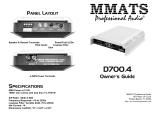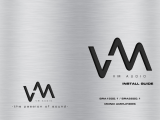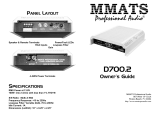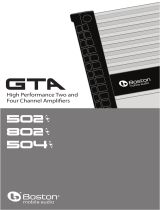Boston Acoustics GT-5750 Owner's manual
- Category
- Audio amplifiers
- Type
- Owner's manual
This manual is also suitable for

5-Channel Amplifier Owners Manual

Introduction
Thank
you
for
choosing
Boston AcousticS®
and
congratulations
on
your
purchase
of
the
Boston
GJTB>
Amplifier.
If
you
own
other
Boston
products,
the
outstanding
audio
performance
and
ease-of-use
of
the
GT
Amplifier
should
come
as
no
surprise.
If
you're
new
to Boston,
welcome
-
you've
made
a
great
choice.
Table
of
Contents
Parts
list
Specifications
Connections
Top panel
removal/installation
Controls
Status LEDs
Installation - General
Before
you
install
Battery and
charging
system
Wire
routing
Mounting
location
Passenger &
trunk
compartment
mounting
Multi-Position
Mounting
Feet
Venting
Installation -
Wiring
Amplifier
fuses
Wire
gauge
Power
12v and
ground
(GND)
connection
Remote
input
connection
Speaker
output
connection
Mono
subwoofer
operation
Tuning
The
Amplifier
- Front and Rear Speakers
Music
Front, Rear, and
Subwoofer
input
sensitivity
controls
Front, Rear, and
Subwoofer
crossover
controls
Rear signal
routing
Head
unit
Volume
5-channel
operation
(independent
RCAs)
switch
configuration
diagram
Input
sensitivity
control
Front
and rear
crossover
controls
Front
and rear
Q-Tune™
control
5-channel
operation
(independent
RCAs)
wiring
configuration
diagram
Tuning The
Amplifier
-
Subwoofer
(s)
Subwoofer
signal
routing
switch
GT-RSL
Head
unit
Volume
5-channel
operation
(single RCAs)
switch
configuration
diagram
Subwoofer
mput
sensitivity
control
Lowpass
crossover
control
Phase
5-channel
operation
(single RCAs)
wiring
configuration
diagram
Amplifier
Troubleshooting
Guide
Service
Information
2
3
4
5
6
7
8
10
12

Parts List
Included Hardware:
Installation
Manual
Female Quick-Connect Terminal
(for
remote
turn-on
input)
2mm
Hex Wrench
3mm
Hex Wrench
Mounting
Screws
Specifications
Technical Specifications:
Front
and
Rear Channels Rated
Power
(CEA-2006-A):
@4-0hm:
@2-0hm:
Subwoofer
Channel
Rated
Power
(CEA-2006-A):
@4-0hm:
@2-0hm:
Front
and
Rear Channels Rated
Power
(12v):
@4-0hm:
Subwoofer
Channel Rated
Power
(12v):
@2-0hm:
Frequency
Response (-3dB):
Signal-to-Noise
Ratio
(A
Weighted):
THD+N:
Highpass
Crossover
(Front
and
Rear Channels):
Frequency
Range:
Slope
(dB Per Octave):
Lowpass
Crossover
(Subwoofer
Channel):
Frequency
Range:
Slope
(dB Per Octave):
Signal
Voltage
Input
Range:
Fuse
Amp
Rating:
Dimensions:
Width:
Height:
Depth:
GT-5750
1
1
1
1
6
GT-5750
70 Watts x 4
100
Watts x 4
250 Watts x 1
375 Watts x 1
50
Wattsx4
275 Watts x 1
10Hz-95kHz
>100dB
0.03
20Hz-
350Hz
12dB
50Hz - 350Hz
12dB
200mv-
Bv
100
Amp
22
~"
(566mm)
2 %"
(61mm)
9"
(229mm)
3

Connections
GT-5750
o
Front
Channel RCA
Input
8 Remote Turn-On
(female
spade
connector
supplied)
8 Rear Channel RCA
Input
o
Subwoofer
Channel RCA
Input
e Remote Gain Port (refer
to
GT-RSL
manual
for
installation
instruction)
o
Front
Left &
Right
Speaker
Outputs
(12-gauge accepted)
8 Rear Left
&
Right
Speaker
Outputs
(12-gauge accepted)
o
Subwoofer
Mono
Speaker
Outputs
(12-gauge accepted)
o 12v
Power
Input
(4-gauge accepted)
«i>
Ground
Wire
Inputs
(4-gauge accepted)
B!P
Panel
Removal/Installation
The
cover
panel is secured
with
two
(2)
3mm
screws. Once
unscrewed,
pull
panel
forward,
once clear
of
the
corners
of
the
end
panels,
it
will
lift
off. Reverse
to
reinstall.
4

Orange
5
Red
o
Front
Channel
Input
Sensitivity
(250mv
to
8.0v -
continuously
variable)
8
Front
Channel Highpass Frequency
Adjustment
(20Hz
to
350Hz - variable)
•
Front
Channel Highpass Crossover OFF/ON
Switch
o
Front
Channel Highpass Crossover
Q-Tune™
Adj.
(0.707
to
1.6 - variable)
e Rear
Signal
Routing
Switch
(Sends
Front
RCA Signal
to
Rear Channels)
0)
Rear Channel
Input
Sensitivity
(250mv
to
8.0v -
continuously
variable)
• Rear Channel Highpass Frequency
Adjustment
(20Hz
to
350Hz - variable)
(3
Rear Channel Highpass Crossover OFF/ON
Switch
CD
Rear Channel Highpass Crossover
Q-Tune™
Adj. (0.707
to
1.6 - variable)
~
Subwoofer
Signal
Routing
Switch
(Sends RCA Signal
to
Subwoofer)
mRear Channel Remote Gain
OFF
/ ON
Switch
(ON
when
using
GT-RSL)
~
Subwoofer
Channel
Input
Sensitivity
(250mv
to
8.0v -
continuously
variable)
~
Subwoofer
Channel
Lowpass
Frequency
Adjustment
(20Hz
to
350Hz - variable)
e
Subwoofer
Channel
Lowpass
Crossover OFF/ON
Switch
(OFF/12dB/24dB)
e Fuse (replace
with
100amp
mini
ANL
only)
Status
LEDs
Controls
The Orange LED
(not
visible
unless lit)
will
illuminate
during
start-up and
under
fault
conditions.
If
this
is
illuminated
after
start-up, please refer
to
troubleshooting
on page 12.
The Boston
Logo
will
illuminate
"Red"
under
normal
operating
conditions.
GT-5750

Installation - General
WARNING! Before
driving
the
amplifier
mounting
screws
through
any
surface, be sure
of
what
is
behind
that
surface. Check
for
the
gas tank, brake lines,
and
any
vehicle
wiring
harness.
Never
run
wires
outside
or
under
the
vehicle
or
where
they
could
become
broken
or
interfere
with
the
safe
operation
of
the
vehicle.
Before You
Install
Before
you
install
the
unit,
disconnect
the
negative
(-)
battery
cable in
the
engine
compartment
of
the
vehicle.
Doing so
will
prevent
damage
to
both
the
electrical system
of
the
vehicle and
the
amplifier
during
installation.
Battery
and Charging
System
In
order
for
the
amplifier
to
function
correctly,
the
electrical system
of
the
vehicle
should
be
professionally
checked
for
overall
electrical capacity.
When
used,
the
amplifier
will
increase
the
demand
on
the
battery
and
alternator. Therefore, both
should
be
thoroughly
evaluated
before
installing
the
amplifier
to
ensure
they
are
in
normal
operating
condition
and
able
to
handle
the
increased
demand
the
amplifier
will
present
to
the
vehicle's
electrical system.
Wire
Routing
Do
not
run
the
power
wire
near
any
low-level
signals
or
audio
cables such as
the
RCAs
from
the
head
unit.
Noise can be
introduced
into
the
amplifier
when
this
occurs. It is
helpful
to
diagram
the
wire
layout
first
before
any
installation
is initiated.
Choose
the
Mounting
Location
Plan
your
installation
so
that
the
amplifier
is
mounted
where
adequate
ventilation
is available.
Never
mount
an
amplifier
in the
engine
compartment
of
a
vehicle!
WARNING!
Before
driving
the
mounting
screws
through
any
surface,
be
sure
of
what
lies
behind
that
surface. Check
for
gas
tank,
brake
lines,
and
any
vehicle
wiring
harness.
Passenger and Trunk
Compartment
Mounting
If
the
amplifier
is
mounted
under
a seat, be sure
that
the
vents
do
not
become
blocked. Do
not
allow
seat
padding
or
other
obstructive
material
to
press
down
on
the
amplifier.
All
Boston
GP'
amplifiers
have
top
panel
controls.
If
the
amplifier
is
mounted
under
a seat,
position
the
amplifier
so
the
cover
panel can be
removed
with
the
seat
forward
or
back
to
allow
adjustment
of
the
audio
settings.
When
mounting
in a
trunk,
choose a
location
that
will
be protected
from
sliding
cargo
or
other
materials.
Mount
the
amplifier
to
solid surfaces only. Do
not
mount
to
plastic
trim
panels. Do
not
mount
the
amplifier
with
Velcro,
double-stick tape,
or
by
wedging
into
position.
Amplifier
should
be
mounted
using
the
movable
mounting
feet
and
the
provided
mounting
screws.
Multi-Position
Mounting
Feet
The
mounting
feet
are designed
to
slide in
both
directions
to
clear
installation
obstructions
on
the
mounting
surface.
Venting
(Side
and
Rear)
The
cooling
vents
must
be kept clear
of
obstructions
once
the
amplifier
is installed.
If
the
vents
are obstructed,
this
could
lead
to
premature
thermal
shutdown
or
amplifier
failure.
6

Installation - Wiring
Amplifier Fuses
Although
the
amplifier
has an
internal
fuse,
additional
fuse
protection
should
be installed as close as
possible
to
the
battery
on
the
positive
(+)
power
wire
going
to
the
amplifier.
An
inline
fuse
should
be installed at
no
more
than
18" (46cm) on
the
positive
(+)
power
wire.
The
rating
of
the
inline
fuse
should
equal
the
value
of
the
internal
fuse
of
the
amplifier
if
only
the
single
amplifier
is
connected
to
this
wire.
If
other
devices are con-
nected
to
this
wire,
the
fuse
value
should
be
of
sufficient
capacity
to
handle
the
demand.
Wire Gauge
The
amplifier
accepts
up
to
4-gauge
stripped
wire
at
the
DC
power
and
ground
input
terminals,
and
4-gauge is
recommended.
Wire
runs
should
be kept
to
the
minimum
practical
length.
Power 12v and Ground (GND) Connection
Strip
approximately
%"
(16mm)
of
insulation.
The
positive
(+)
power
wire
is installed
into
the
amplifier
terminal
marked
"12v".
The
negative
(-)
wire
is installed
into
the
terminal
marked
"GND".
The
ground
wire
should
be
as
short
as
possible
and
connected
directly
to
the
chassis
of
the
vehicle. Make sure
that
the
chassis
connection
point
is free
of
rust, grease,
dirt,
paint,
and
other
materials
that
may
insulate
the
ground
wire
from
making
proper
connection.
lighten
the
12v
and
GND
terminals
with
the
supplied
3mm
hex
wrench
to
secure
the
wire
into
the
terminals.
If
the
power
wire
must
be
routed
through
a
drilled
or
existing
hole, use a
nylon
panel
grommet
to
prevent
the
insulation
from
fraying.
Failure
to
do
so
could
lead
to
an electrical
short
if
the
wire
insulation
is
worn
through
and
the
power
wire
is
shorted
to
ground.
Remote Input Connection
Use
the
supplied
FEMALE
quick-connect
terminal
to
connect
the
REMOTE
trigger
lead
from
the
head
unit
to
the
amplifier.
Crimp
connector
to
wire
from
head
unit
that
controls
remote
turn-on
(refer
to
head
unit
owner's
manual).
Once
the
quick-connect
terminal
is
crimped
into
place,
carefully
push
connector
onto
recessed MALE
REMOTE
terminal
adjacent
to
the
RCA
input
pair
(refer
to
the
diagram
on
page 4).
Speaker Output Connection
Prepare each
wire
by
stripping
approximately
%"
(16mm)
of
insulation.
The
positive
(+) speaker
wires
are
installed
into
the
amplifier
terminals
marked
"SPEAKER
OUTPUT"
/
"+"
(refer
to
the
diagram
on
page 4).
The
negative
(-)
speaker
wires
are
installed
into
the
amplifier
terminals
marked
"SPEAKER
OUTPUT"
/
"-".
lighten
the
"SPEAKER
OUTPUT",
"+",
and
"-"
terminals
with
the
supplied
2mm
hex
wrench
to
secure
the
wires
into
the
terminals.
If
the
speaker
wires
must
be
routed
through
a
drilled
or
existing
hole, use a
nylon
panel
grommet
to
prevent
fraying
the
wire
insulation.
Failure
to
do
so
could
lead
to
an electrical
short
if
the
wire
insulation
is
worn
through
and
the
speaker
wires
are
shorted
to
ground.
Mono
Subwoofer Operation
Refer
to
the
diagram
on
page
4.
WARNING!
Subwoofer
impedance
must
not
fall
below
2
ohms
when
in
MONO
mode.
7

Tuning The Amplifier - Front
and
Rear
Sp_ea_k_e_r_s
_
1)
Music
The material chosen
for
system
tuning
must
be both clear in recording quality and
dynamic
in amplitude.
Many
audiophile
"test"
discs have musical tracks
with
both
of
these characteristics and should be used.
2)
Front, Rear, and
Subwoofer
Input
Sensitivity Controls
Turn controls all
the
way
counterclockwise
(minimum
position). In this position,
the
amplifier
will
be less sensitive
to
the
input
signal
from
the
head
unit
(refer
to
the
diagram
on
page
5).
3)
Front, Rear, and
Subwoofer
Crossover Controls
Crossovers should be turned "OFF" during this phase
of
setup.
Move
the HIGHPASS and LOWPASS switches
to
the
"OFF" position
(refer
to
the
diagram
on page 5),
with
these settings, full-range signal is sent
to
the speaker
outputs.
4)
Rear Signal Routing
If using separate RCAs
for
Front and Rear
move
switch
to
"Dedicated Front and Rear
RCA
Inputs". When using a
single
RCA
for
both Front and Rear Channels,
move
the
switch
to
"Send
Front
RCA
Signal
to
Rear".
5)
Head
Unit
The head
unit
should have all controls such
as
bass, treble, balance, and fader set
to
the
flat
or
centered position.
The
volume
control should be at
the
minimum
setting. Ifthe head
unit
has any equalization
or
bass
management
features such
as
boost,
they
should be defeated at this time. Turn head
unit
on, and verify
that
the
RED
status
LED
(logo) is illuminated on the amplifier.
6)
Volume
With
the chosen musical track playing,
turn
the
head
unit
volume
control
up
until
the
maximum
level
of
undistorted signal is heard
from
the
speakers. (For
most
head units,
this
will
be near
the
end
of
the
volume
control range.)
WARNING! A distorted signal
from
the head
unit
sent
to
the
amplifier
can cause loudspeaker failure at
higher
listening levels.
f<95l f<95l
f<95l
1=
./
ffT!5~~IJ
=
~Bosto~"
=
=
mob'leaudio
=
=
((
m'\
=
=
=
1=
0 0
:=
1=
1=
II
_~
~~~~
m=J
-OO-I·5!J!=
_l
·r
\
;:::
.-:~-
.::~?
-..:~:
~
tid
EftilCitfB
--_
..
:~.
..
:@.::
---
·:itJ":
..
:it}::'
--_.~.
b@]]
...
.. .
..
-
1
~
W
F-
e-
L
5-Channel
Operation
(Independent
RCAs)
Switch
Configuration
Diagram
8

9
5-Channel
Operation
(Independent
RCAs)
Wiring
Configuration
Diagram
)
••
••
___
....
....:....l."'"_....:....l.....:....l.
•....:....l.'"'-.J
::
Setting the Q-Tune'· control is done in conjunction
with
setting the levels on the
input
sensitivity and highpass
crossover frequency controls. You
may
find
while
setting the Q-Tune'· that over-excursion
may
be detected in the
front speakers; lowering the Q-Tune'·
input
sensitivity
or
raising the highpass crossover point will eliminate this.
Minor
adjustments
to
each setting are required
to
fine-tune the system.
Setting the Q-Tune'· is a subtle process. It is recommended that the Q-Tune'· setting be left in the
0.7
position and
adjusted
only
after the
input
sensitivity and highpass crossover ranges are known. Small adjustments
to
the Q-Tune'·
setting are all that are required
to
fine-tune the system.
Tuning The Amplifier - Front
and
Rear
Sp_e_ak_e_r_s
_
7)
Input
Sensitivity Control
Starting
with
the front channels,
slowly
rotate the control clockwise (refer
to
the
diagram
on page
5)
until maxi-
mum
undistorted playing level is heard
from
the speakers. Listen closely
for
bottoming
from
the speakers. If detect-
ed, rotate the
input
sensitivity control counterclockwise until
it
is eliminated. Repeat
for
the rear channels.
8)
Front and Rear Crossover Controls
To
achieve higher undistorted playing levels
from
the both the
front
and rear speakers, the highpass crossover
must
be engaged. Starting
with
the
front
channels, rotate the crossover control fully clockwise (refer
to
the
diagram
on
page 5). The highpass crossover point is
now
set at 350Hz. Rotate "Q-Tune'·" Control
fully
counterclockwise (front
and rear channels only).
Move
crossover switch
to
the right (ON) position.
Slowly
rotate the
input
sensitivity control clockwise until
maximum
undistorted playing level is heard
from
the
speakers. Listen closely
for
bottoming
from
the speakers.
If
detected, rotate the
input
sensitivity control counterclock-
wise until
it
is eliminated.
Slowly
rotate the highpass crossover control counterclockwise while listening
for
bottoming.
You
are lowering the crossover point, which means
that
more
bass signal is being sent
to
the speakers. If
bottoming is detected, rotate the
input
sensitivity control counterclockwise until
it
is eliminated and/or rotate the
Highpass crossover control clockwise
to
raise the crossover point. Repeat
for
the rear channels.
9)
Front and Rear a-Tune"" Control
Once the highpass crossover point has been determined, use the
Q-Tune~
control (refer
to
the
diagram
on page
5)
to
increase the bass information centered around the crossover point.

Tuning The Amplifier - Subwoofer
(s)
1)
Subwoofer
Signal
Routing
Switch
Move
switch
to
left
position
(L+R Inputs)
when
used
with
Left and Right
subwoofer
RCA outputs.
Move
switch
to
middle
position
(L
Mono
Input)
when
used
with
single
subwoofer
RCA
outputs.
Move
switch
to
right
posi-
tion
(Signal
from
Front RCA)
when
subwoofer
signal is
to
be
derived
from
front
and rear channels.
2)
GT-RSL
The
remote
level
control
(GT-RSL) gives
you
independent
level
adjustment
of
the
subwoofer's
output
level
beyond
the
standard system
volume
control. Please refer
to
the
RSL's
manual
for
installation
instruction.
The
GT-RSL is available separately, please
consult
your
authorized Boston Acoustics dealer.
If
no
GT-RSL is used,
switch
is set
to
"
Off"
.
3)
Head
Unit
The head
unit
should
have all
controls
such as bass, treble, balance, and
fader
set
to
the
flat
or
centered
position. The
volume
control
should
be at
the
minimum
setting.
If
the
head
unit
has
any
equalization
or
bass
management
features such
as
boost,
they
should
be deactivated at
this
time.
Turn head
unit
on, and
verify
that
the
RED
status
LED
(logo) is
illuminated
on
the
amplifier.
4)
Volume
With
the chosen musical track playing,
turn
the
head
unit
volume
control
up
until
the
maximum
level
of
undistorted
signal is heard
from
the
speakers. For
most
head units,
this
will
be
at
the
end
of
the
volume
control
range.
WARNING! A
distorted
signal
from
the
head
unit
sent
to
the
amplifier
can cause speaker
failure
at
higher
listening levels.
r©5l
r©5l
r©5l
OIl
::
'-
./
Q>805tO~
/IlGT·~~11
~
=
mobi!eaudio
~
1=
((
m
\'
~
~
=
~
0
0
=
=
;::
::
II
_~
~S~
""c:;;p:l==
-OO-I,~~
_~J(
\
,~.~-
'~~:
'-.:.~:
00'.:.,"00
----y
~
---_
..
~.
,
..
:~:.:
----
...
~:'
':~:.
~~~
D~
:=
....
...
..
~~~
1-1
IL
~
W
,...
L
5-Channel
Operation
(Single RCA)
Switch
Configuration
Diagram
10

Tuning The Amplifier - Subwoofer (5)
5)
Subwoofer
Input Sensitivity Control
Turn
control
(refer
to
the
diagram
on
page
5)
all
the
way
counterclockwise
(minimum
position).
In
this
position,
the
amplifier
will
be less
sensitive
to
the
input
signal
from
the
head
unit.
Slowly
rotate
this
control
clockwise
until
maximum
undistorted
playing
level is
heard
from
the
subwoofer(s).
Listen
closely
for
faults
such as
bottoming
from
the
subwoofer(s).
If
fault
is
detected,
rotate
input
sensitivity
control
counterclockwise
until
fault
is
eliminated.
At
this
point,
the
maximum
undistorted
subwoofer
playing
level has been
defined
8) Lowpass Crossover Control
Move
the
selector
switch
to
either
12dB
or
24dB
(refer
to
the
diagram
on
page
5). In
this
setting,
lowpass
sig-
nal is
sent
to
the
subwoofer
outputs.
Experiment
with
the
crossover
point
settings
while
the
subwoofer
is
active. A
higher
setting
will
increase
the
perceived
output,
and
a
lower
setting
will
make
the
bass response
more
omnidirectional.
9) Phase
Subwoofer
phase is
relative
to
the
front
and
rear loudspeakers.
Correct
electrical phase
does
not
always
mean
correct
acoustic
phase.
Swap
positive
(+)
and
negative
(-)
connections
at
the
speaker
outputs
where
the
sub-
woofer
is
connected
to
the
amplifier.
It is
beneficial
to
listen
to
the
subwoofer
connected
in
both
phase
condi-
tions.
The
subwoofer
should
be
left
in
the
condition
in
which
the
strongest
bass response is
noted.
~(
)
W"(
..
~'")::
••
..
__
....
5-Channel Operation (Single RCA) Wiring Configuration Diagram
11

Amplifier Troubleshooting Guide
Status
LEOs
on
Amplifier
not
Lit-Head
Unit
(Source)
Turned
NON"
Verify
Remote
turn-on
wire
from
source
to
amplifier
has
proper
voltage
Power
(B+)
connections
at
amplifier,
terminal
blocks,
and
battery
are
secure
Ground
(GND)
connections
at
amplifier
and
vehicle
chassis are secure
Battery
B+
fuse
and
amplifier
fuse
are OK
B+
at
battery
and
B+
at
amplifier
have
proper
voltage
Status
LEOs
Lit,
no
Output
from
Speakers-Speakers
in
Normal
Operating
Condition
Verify
High-level
cables
from
speaker(s)
to
amplifier
are
securely
connected
RCA cables
from
amplifier
to
source
are
securely
connected
Sensitivity
adjustment
on
amplifier
is
correctly
adjusted
Engine
Noise
from
Speaker(s)
Turn
source
"OFF"
and
disconnect
RCA cables
at
amplifier
If
noise
stops, check
equipment
and
cables
leading
to
amplifier
Verify RCA cables are
of
good
quality
with
no
breakage
to
internal
shields
RCA cables
from
source
to
amplifier
are
not
run
alongside
power
Amplifier
Output
Distorted-Music
not
Recorded
with
Intentional
Distortion
Verify Source
output
to
amplifier
is
not
distorted
Amplifier
input
sensitivity
is
correctly
adjusted
Amplifier
Shutting
Down,
Red
Blinking
and
Orange
LEOs
Lit-Amplifier
in
Thermal
Protection
Mode
Verify
Amplifier
is
mounted
with
adequate
air
circulation
around
vents
Amplifier
does
not
have
obstructions
blocking
back
or
side
panel
vents
Amplifier
is
not
mounted
under
carpet
Speakers
meet
correct
impedance
for
application
(mono
or
stereo
hookup)
Amplifier
not
Turning
NON",
Orange
LED
Lit-Amplifier
not
Connected
to
a
Shorted
Speaker
Verify Speaker
crossover
is
not
defective
High-level
cables
from
speaker
to
amplifier
are
not
shorted
Amplifier
not
Turning
And
Both
LED (s)
Blinking-Speakers,
Crossovers,
and
Cable
OK
Internal
fuse needs
to
be replaced
Verify Replace
fuse
with
fuse
of
same
value
Amplifier
not
Turning
"ON",
Orange
LED
Lit-Speakers,
Crossovers,
and
Cable OK
Amplifier
requires
service
If
Service
Seems
Necessary
First,
contact
the
dealer
from
whom
you
purchased
the
product,
or
contact
us
via
e-mail
at:
USA
and
Canada:
Europe:
Japan:
Asia/Pacific
countries:
We
will
promptly
advise
you
of
what
action
to
take.
Boston
Acoustics,
Inc. 300
Jubilee
Drive,
Peabody,
MA
01960
USA
T:
978.538.5000
F:
978.538.5100 W:
bostonacoustics.com
Boston, Boston
GT,
Boston Acoustics, and the Boston Acoustics
logo
are registered trademarks and DualMode and Q-Tune are trademarks
of
Boston Acoustics, Inc.
Specifications are subject
to
change without notice. © 2009 Boston Acoustics, Inc. All rights reserved. Covered
by
patents issued
and/or
pending. 142-003180-0
-
 1
1
-
 2
2
-
 3
3
-
 4
4
-
 5
5
-
 6
6
-
 7
7
-
 8
8
-
 9
9
-
 10
10
-
 11
11
-
 12
12
Boston Acoustics GT-5750 Owner's manual
- Category
- Audio amplifiers
- Type
- Owner's manual
- This manual is also suitable for
Ask a question and I''ll find the answer in the document
Finding information in a document is now easier with AI
Related papers
Other documents
-
Boston GT-22 Owner's manual
-
 VM Audio SRD12SBS Install Manual
VM Audio SRD12SBS Install Manual
-
 MMATS Professional Audio Speaker D700.4 User manual
MMATS Professional Audio Speaker D700.4 User manual
-
 VM Audio SRA2200.1 Specification
VM Audio SRA2200.1 Specification
-
 MMATS Professional Audio D700.2 User manual
MMATS Professional Audio D700.2 User manual
-
Boston GTA-802 User manual
-
Boston GT-50 Owner's manual
-
Kicker ZX460 Amplifier User manual
-
Boston GT-28 Features
-
Orion Car Audio XTREME 600.4 User manual
















